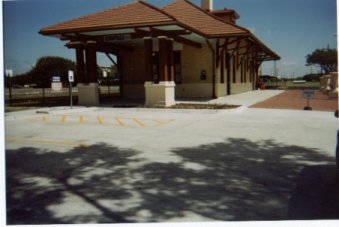
Very little was happening in this wild flat coastal plain,
interrupted here and there by salty bays, when the Spaniard explorers arrived on the shores.
They soon surveyed and mapped the coast of the Gulf of Mexico, calling the barrier island,
part of which is in Kleberg County,La Isla Blanco [Padre Island]. They found the area
to be inhabited by Karankawa and Coahuiltecan Indians. The Indians had subsisted for centuries
here in this land of very little water by eating roots, mesquite beans, prickly pear and any
animals they could kill. The 1940s witnessed
a period of spectacular growth similar to that of the 1920s. The
population rose from 7,782 in 1940 to 16,857 in 1950. This growth was due
primarily to the location of the Naval Auxiliary Station (later the Naval
Air Station, Kingsville) three miles southeast of Kingsville and the
erection of the Celanese plant four miles to the north, a short distance
across the Nueces county line. The naval base brought in a large influx of
personnel, and most of the Celanese employees made their homes in
Kingsville. Although the county
experienced a reverse in the 1950s, when the railroad closed its general
office and shops and moved its employees elsewhere, the population
continued to grow. The prosperous oil industry, the rising enrollment at
the college, and the strength of the agricultural economy contributed to
this growth.
SOURCES: Sterling Bass, History of Kleberg County (M.A. thesis,
University of Texas, 1931). Kleberg County Historical Commission,
Kleberg County, Texas (Austin: Hart Graphics, 1979). Tom Lea,
The King Ranch (2 vols., Boston: Little, Brown, 1957).
Much of this land North of the Rio Grande was granted to the Spanish who had settled in the
towns along the lower Rio Grande. After Mexico won its independence from Spain in 1821,
additional land grants were made by the new government of Mexico. It was in 1853 that Richard King
purchased the Santa Gertrudis grant from the heirs of the original Spanish grantees. From this
purchase grew the famous King Ranch.
By this time the area was included in the State of Texas and
also in the county of Nueces. The history of this area, now known as Kleberg County, during the next
fifty years is synonymous with that of the ranch, the King family and those who lived and
worked there. It was 1903 before the fruition of longtime dream of Uriah Lott to extend railway service
to the Lower Rio Grande Valley. Uriah Lott, with the help of the citizens of the area, convinced B.F. Yoakum
that the time was right and the St. Louis, Brownsville, and Mexico Railway was
built through South Texas to Brownsville.
At this same time, 1904, the shrewd owner of the King Ranch, Henrietta King,
opened a large tract of her land for sale. She employed a surveyor, Anton Felix H. von Blücher, to lay out a town, Kingsville, three miles
in a pasture three miles east of the ranch headquarters. The first new owners began to arrive in 1904. Some came to
looking for farm lands, some came to work on the railroad. By 1912 there were approximately 4,000 people
living in Kingsville.
Other small communities were formed in the county. Ricardo, located on the railroad, was started in 1908 as a
trading center for farmers living nearby. Theodore F. Koch purchased around 20,000 acres from Mrs. King in 1907.
He established Riviera. Koch soon organized a vacation resort which he called Riviera Beach.
In 1908 a community of German American families sponsored by the Catholic Colonization Society settled
several miles to the northeast of Riviera, calling their community, Vattman.
The population grew so rapidly after the railway came to the area that the citizens petitioned to become a county.
In 1913 the Texas legislature organized Kleberg County from an area which had been in Nueces County. Kingsville was
named the county seat.
An election was held to choose citizens to serve on a commissioners' court. This governing body
proposed that a courthouse and hospital be built; the
voters approved bond issues for their construction, and both were
completed by 1914. A movement was started to improve existing roads and
build others. In 1919 the citizens voted a $350,000 bond issue to
construct a hard-surfaced highway. When it was finished, the road ran
southward from the Nueces County line through Kingsville and Ricardo to
Riviera. Oil exploration began early in the county; in 1919 the first
producing well was discovered. During the next fifty years county wells
produced around 178 million barrels. The first industry in the county was
a cotton mill started in Kingsville in 1921. An additional stimulus
occurred in 1925, when South Texas Teachers College (now Texas A&M
University at Kingsville) was established.